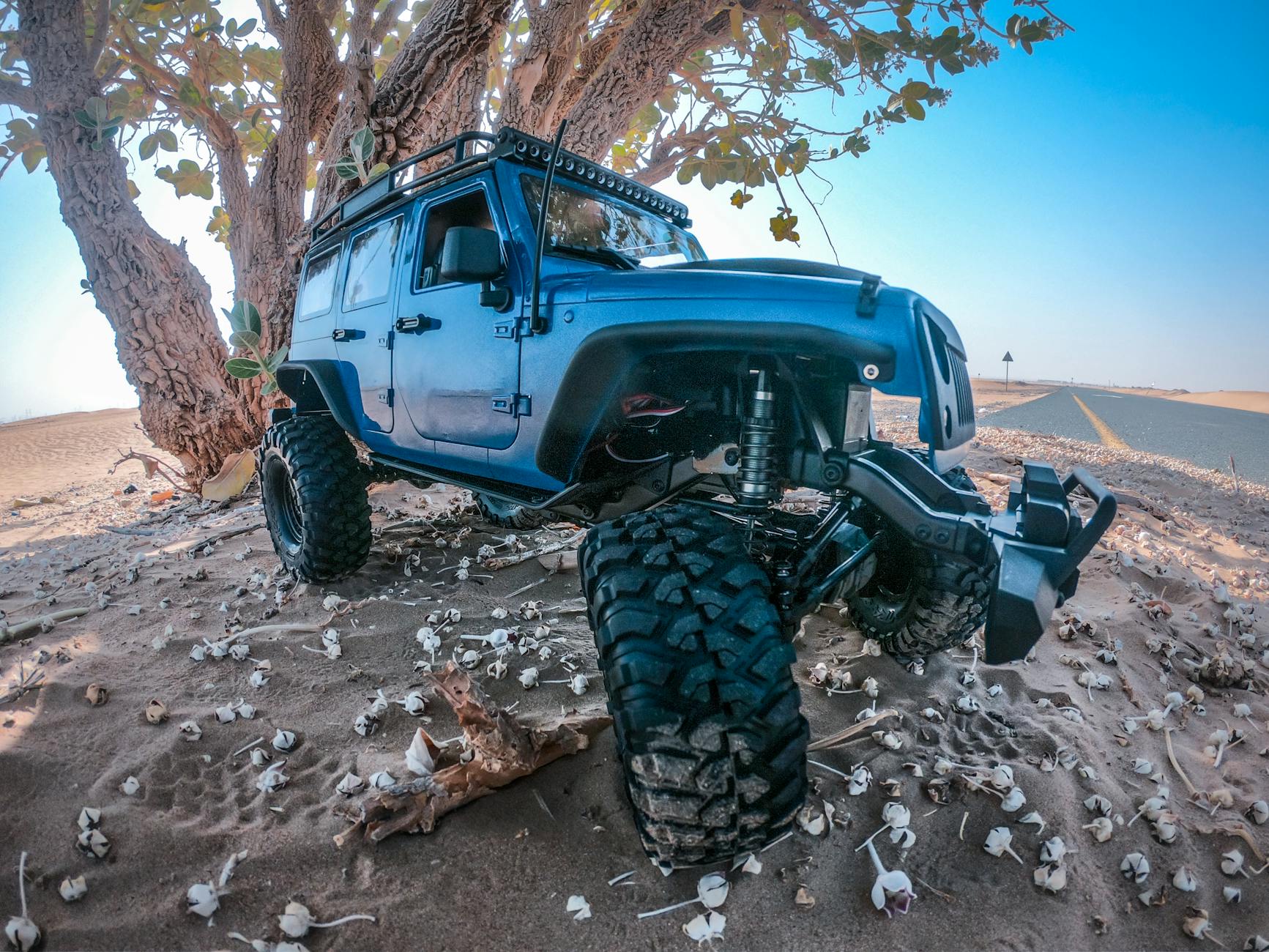Understanding Off-Road Tires
Off-road tires play a vital role in enhancing the performance and capabilities of a vehicle in challenging terrains. Whether you enjoy off-roading as a hobby or rely on your vehicle for work purposes, having the right off-road tires can make a significant difference in conquering various terrains with confidence. Let’s explore the importance of off-road tires and the factors to consider before buying them.
Importance of Off-Road Tires
Off-road tires are specifically designed to handle difficult terrains, such as mud, rocks, sand, and other materials. Their unique features and construction enable them to provide enhanced traction, durability, and performance in off-road conditions. By equipping your vehicle with the appropriate off-road tires, you can experience improved control, stability, and maneuverability on challenging surfaces.
The benefits of off-road tires extend beyond their performance capabilities. These tires also contribute to the aesthetics of your vehicle, giving it a rugged and adventurous look. Whether you’re navigating through muddy trails or traversing rocky landscapes, off-road tires are designed to withstand the demands of such conditions, ensuring a safer and more enjoyable off-road experience.
Factors to Consider Before Buying Off-Road Tires
Before purchasing off-road tires, it’s essential to consider several factors to ensure you choose the right tires for your needs. Here are some key considerations:
-
Intended Terrain: Different off-road tires are designed for specific terrains, such as rocky terrains, muddy trails, or snow-covered surfaces. It’s crucial to assess the types of terrains you will be encountering to select tires that provide optimal traction and performance. Consider the unique challenges of each terrain and choose off-road tires accordingly.
-
Tire Size: Determining the correct tire size for your off-road vehicle is vital. Not all four-wheel drives can accommodate large tires, so it’s important to know the accurate tire size suitable for your vehicle. Refer to the manufacturer’s guidelines or consult a professional to ensure you select the appropriate tire size for optimal performance and compatibility.
-
Budget: Budget is an important consideration when buying off-road tires. Having a clear idea of your budget will help you narrow down the available options. While high-quality off-road tires may come at a higher price point, they often offer superior performance, durability, and longevity. If you’re on a tight budget, you may also consider purchasing second-hand off-road tires that are still in good condition.
-
Tread Pattern: The tread pattern of off-road tires is designed to provide maximum traction in specific terrains. Consider the tread pattern that suits your intended off-road activities. For example, aggressive tread patterns with larger lugs are suitable for muddy terrains, while tires with smaller, tightly packed lugs are better for rocky surfaces.
-
Load Carrying Capacity: Off-road tires should be capable of carrying the load of your vehicle and any additional gear or equipment. Check the load carrying capacity of the tires to ensure they can handle the weight requirements of your vehicle and any off-road accessories.
By carefully considering these factors, you can make an informed decision when selecting off-road tires that best suit your driving needs and preferences. Keep in mind that consultation with a tire specialist or an off-road enthusiast can provide valuable insights and recommendations based on their expertise.
In the next section, we will explore different types of off-road tires, including all-terrain tires, mud-terrain tires, winter/snow tires, and sand tires, to help you choose the most suitable option for your off-road adventures.
Types of Off-Road Tires
When it comes to off-road driving, having the right tires can make all the difference. There are several types of off-road tires available, each designed to excel in different terrains and weather conditions. Let’s explore the most common types of off-road tires: all-terrain tires, mud-terrain tires, winter/snow tires, and sand tires.
All-Terrain Tires
All-terrain tires are a versatile option for those who frequently switch between highways and off-road terrains. These tires feature large blocks and deep grooves in the tread, providing excellent traction on various surfaces. The smaller center blocks contribute to better traction on paved roads and reduce noise levels during highway driving.
One of the key advantages of all-terrain tires is their year-round usability, including in cold winters. However, their performance in temperatures below 7°C may be less optimal compared to dedicated winter/snow tires. All-terrain tires are an excellent choice for individuals seeking a balance between off-road capabilities and on-road comfort.
| Tire Type | Tread Pattern | Usability | Performance in Winter |
|---|---|---|---|
| All-Terrain Tires | Large blocks and deep grooves | Year-round | Mediocre below 7°C |
Source: UTires
Mud-Terrain Tires
Mud-terrain tires are specifically designed for off-road use, particularly on muddy terrains. These tires feature more aggressive tread patterns with larger blocks and wider channels. The deeper grooves help to prevent mud from packing in, ensuring consistent traction in challenging conditions.
Mud-terrain tires also have stiff sidewalls, allowing them to absorb shocks and impacts on uneven surfaces. However, it’s important to note that these tires may not provide optimal stability on icy surfaces due to their limited contact patch area. If you frequently encounter muddy terrains, mud-terrain tires are an excellent choice.
| Tire Type | Tread Pattern | Usability | Performance on Ice |
|---|---|---|---|
| Mud-Terrain Tires | Aggressive tread patterns, large blocks, wider channels | Off-road use | Limited stability |
Source: UTires
Winter/Snow Tires
Winter/snow tires are specifically designed for cold seasons, offering superior performance in snowy and icy conditions. These tires are made from a softer rubber compound that remains pliable in temperatures below 7-10°C. They feature thinner grooves on the tread blocks called sipes, which enhance traction on snow and ice.
Winter/snow tires provide excellent grip and control, helping you navigate through winter conditions with confidence. However, it’s important to note that they are not suitable for year-round use and may wear out quickly on warmer surfaces. If you live in an area with harsh winters, investing in a set of winter/snow tires is highly recommended.
| Tire Type | Tread Pattern | Usability | Suitable Seasons |
|---|---|---|---|
| Winter/Snow Tires | Softer rubber compound, thinner grooves/sipes | Cold seasons | Winter only |
Source: UTires
Sand Tires
Sand tires are specialized for driving on sandy surfaces, typically used for specific sport activities and tours. These tires feature unique tread designs and extrusions that help churn sand and provide excellent traction. The design allows the tires to efficiently move through sand without sinking or getting stuck.
If you frequently drive on sandy terrains, such as beaches or deserts, investing in sand tires can greatly enhance your off-road experience. These tires are designed to excel in sandy conditions, providing the necessary grip and performance.
| Tire Type | Tread Pattern | Usability |
|---|---|---|
| Sand Tires | Specialized tread designs and extrusions | Sandy terrains |
Source: UTires
By understanding the different types of off-road tires available, you can choose the one that best suits your specific needs and driving conditions. Whether you opt for all-terrain tires, mud-terrain tires, winter/snow tires, or sand tires, make sure to consider the terrain, weather, and your driving requirements to ensure optimal performance and safety on your off-road adventures.
Features of Off-Road Tires
Off-road tires are specifically designed to conquer challenging terrains and provide enhanced traction and durability. Understanding the key features of off-road tires can help you make an informed decision when choosing the right tires for your off-road adventures.
Tread Patterns and Design
One of the distinguishing features of off-road tires is their aggressive tread patterns and designs. These tires are equipped with deeper treads and larger lugs, which allow for better traction and grip on challenging terrains such as mud, snow, and rocks (Forbes). The deeper treads help to channel water, mud, and snow away from the tire, reducing the risk of hydroplaning and maintaining traction (Forbes). The larger lugs provide additional biting edges, ensuring a strong grip on uneven surfaces.
Sidewall Reinforcement
Off-road tires are equipped with reinforced sidewalls to withstand the rigors of off-road driving. These sidewalls are designed to provide extra protection against punctures and damage from rocks, debris, and sharp objects encountered during off-road adventures (Forbes). The reinforced sidewalls enhance the durability of the tires, allowing them to withstand rough terrains and provide a reliable performance.
Tire Size and Load Capacity
Off-road tires are often wider than regular tires, providing a larger contact patch with the ground and better stability on uneven surfaces (Forbes). The wider footprint helps to distribute the weight of the vehicle more evenly, reducing the risk of sinking in soft terrains. Additionally, off-road tires are designed to handle heavier loads compared to standard tires, allowing you to carry additional gear and equipment for your off-road adventures.
To determine the appropriate tire size and load capacity for your vehicle, refer to the manufacturer’s recommendations or consult with a professional tire expert. It’s essential to choose tires that are suitable for your vehicle’s weight and intended off-road activities to ensure optimal performance and safety.
Understanding these features of off-road tires can assist you in selecting the right tires for your off-road excursions. Whether you opt for all-terrain, mud-terrain, winter/snow, or sand tires, considering the tread patterns, sidewall reinforcement, and tire size/load capacity will help you navigate through challenging terrains with confidence. Don’t forget to regularly inspect and maintain your off-road tires to ensure their longevity and optimal performance.
Best Off-Road Tire Brands
When it comes to off-road adventures, having the right tires can make all the difference. There are several tire brands that are highly regarded for their performance and durability in challenging terrains. In this section, we will explore some of the best off-road tire brands, including BF Goodrich, Nitto, Toyo, Falken, and Cooper Discoverer.
BF Goodrich
BF Goodrich is a renowned brand in the off-road tire industry, consistently recognized for their exceptional quality and performance. Their tires are designed to tackle rugged terrains with ease, providing excellent traction and durability. BF Goodrich tires are known for their aggressive tread patterns, which enhance off-road capabilities while still maintaining good on-road manners. Whether you’re traversing rocky trails or muddy paths, BF Goodrich tires are built to conquer any challenge.
Nitto
Nitto is a popular choice among off-road enthusiasts, offering a range of tires that strike a balance between on-road comfort and off-road performance. Nitto tires are designed with advanced technology to provide excellent traction, stability, and durability. With their aggressive tread designs and strong sidewalls, Nitto tires deliver impressive performance in various off-road conditions. Whether you’re tackling muddy trails or rocky surfaces, Nitto tires are engineered to handle the demands of off-road adventures.
Toyo
Toyo is another brand that stands out in the off-road tire market. Known for their aggressive tread patterns and superior traction, Toyo tires are built to handle rough terrains with ease. They offer a wide range of tire sizes to accommodate different vehicles and provide optimal performance. Whether you’re venturing into snowy landscapes or rocky trails, Toyo tires provide the grip and control you need for a confident off-road experience.
Falken
Falken tires are favored by off-road enthusiasts for their rugged construction and excellent off-road capabilities. With their strong sidewalls and aggressive tread patterns, Falken tires excel in muddy, rocky, and uneven terrains. They offer enhanced traction and stability, allowing you to tackle challenging off-road conditions with confidence. Falken tires are designed to provide long-lasting performance, making them a reliable choice for off-road adventurers.
Cooper Discoverer
Cooper Discoverer tires are highly rated for their off-road performance and durability. Engineered with deep tread patterns and reinforced construction, Cooper Discoverer tires offer excellent traction and stability on various off-road surfaces. Whether you’re navigating through sandy dunes or rocky trails, Cooper Discoverer tires deliver reliable performance and enhanced durability. With their ability to withstand tough off-road conditions, Cooper Discoverer tires are a popular choice for off-road enthusiasts.
When choosing off-road tires, it’s important to consider factors such as tread patterns, sidewall reinforcement, and tire size. These brands have established themselves as leaders in the off-road tire market, consistently providing reliable and high-performing options for off-road enthusiasts. By selecting tires from trusted brands like BF Goodrich, Nitto, Toyo, Falken, or Cooper Discoverer, you can equip your vehicle with the best off-road tires for your adventurous journeys.
Maintenance and Care for Off-Road Tires
To ensure optimal performance and longevity of your off-road tires, regular maintenance and care are essential. By following a few simple steps, you can keep your tires in excellent condition and maximize their off-road capabilities.
Regular Inspections and Maintenance
Regular inspections are crucial for identifying any signs of damage, wear, or potential issues with your off-road tires. It’s recommended to inspect the tires before and after each off-road excursion, as well as during routine maintenance checks.
During the inspection, check for any visible damage, such as cuts, punctures, or bulges on the tire surface. Additionally, examine the tread pattern and depth to ensure it meets the manufacturer’s recommendations. If you notice any abnormalities or concerns, it’s advisable to consult a professional for further evaluation and potential repairs.
Proper Tire Pressure and Tread Depth
Maintaining the correct tire pressure is vital for off-road tires’ performance and safety. Improper tire pressure can affect traction, handling, and even fuel efficiency. Refer to your vehicle’s owner’s manual or the tire manufacturer’s recommendations to determine the appropriate tire pressure for your off-road tires.
In addition to tire pressure, regularly check the tread depth of your off-road tires. Tread depth plays a critical role in providing traction and grip on various terrains. If the tread depth is too low, it can significantly impact your tire’s ability to maintain traction, especially in off-road conditions. Consider using a tire pressure gauge to measure the depth and ensure it meets the minimum requirements.
Rotation and Balancing
Rotating and balancing your off-road tires is essential for promoting even wear and extending their lifespan. Off-road driving can place uneven stress on tires, depending on the terrain and driving conditions. Rotating the tires at regular intervals, typically every 6,000 miles or as recommended by the tire manufacturer, helps ensure that they wear evenly.
Balancing the tires involves distributing the weight evenly around the wheel and tire assembly. This process helps eliminate vibrations and promotes a smoother ride. It’s recommended to have your off-road tires balanced whenever you rotate them or if you notice any vibrations while driving.
By following these maintenance and care practices, you can keep your off-road tires in optimal condition and enhance their performance during your off-road adventures. Regular inspections, maintaining proper tire pressure, monitoring tread depth, and performing rotation and balancing will contribute to the longevity and reliability of your off-road tires. Remember, if you have any concerns or need professional assistance, consult with a certified tire technician or visit a reputable tire service center.
Off-Road Tires vs. Standard Tires
When it comes to choosing tires for your vehicle, understanding the difference between off-road tires and standard tires is essential. Off-road tires are specifically designed to tackle challenging terrains, providing better traction and durability compared to standard tires. Let’s explore the key differences between these two tire types.
Differences in Tread Pattern and Design
One of the most prominent distinctions between off-road tires and standard tires lies in their tread patterns and designs. Off-road tires feature a more aggressive tread pattern with larger lugs, which are the raised areas on the tire surface. These larger lugs enhance traction and grip on uneven and slippery surfaces, such as mud, gravel, and rocks. They are designed to dig into the terrain, providing maximum traction and preventing slippage. This allows off-road vehicles to conquer challenging terrains with ease.
On the other hand, standard tires have a less aggressive tread pattern with smaller lugs. They are optimized for regular road use, offering a smooth and quiet ride on paved surfaces. While standard tires provide adequate traction for everyday driving conditions, they may not perform as well on off-road surfaces that require enhanced grip and traction.
Durability and Construction
Off-road tires are built with a stronger and more durable construction compared to standard tires. They are designed to withstand the rigors of off-road driving, where the tires are exposed to rough terrains, sharp objects, and potential hazards. Off-road tires are constructed with thicker sidewalls, which provide additional protection against punctures and cuts. This robust construction helps ensure that the tires remain intact and can withstand the demands of off-road adventures.
Standard tires, on the other hand, are designed for regular road use and prioritize comfort and fuel efficiency. They typically have thinner sidewalls and a lighter construction to provide a smoother ride on paved surfaces. While standard tires are sufficient for everyday driving, they may not hold up as well in off-road conditions where the risk of damage is higher.
Suitability for Different Surfaces
Off-road tires are specifically engineered to excel in challenging terrains such as mud, snow, sand, and rocky surfaces. Their aggressive tread patterns and durable construction make them well-suited for off-road adventures. These tires provide enhanced traction and grip, allowing your vehicle to navigate through difficult terrain with confidence. Whether you’re tackling muddy trails, snowy roads, or sandy dunes, off-road tires are designed to keep you in control.
Standard tires, on the other hand, are optimized for regular road conditions. They perform well on paved surfaces and provide a comfortable and smooth ride. However, they may struggle to deliver the same level of traction and grip as off-road tires on challenging terrains. If you frequently venture off-road or encounter rough surfaces, equipping your vehicle with off-road tires is crucial to ensure optimal performance and safety.
It’s important to note that off-road tires are not recommended for regular road use. Due to their aggressive tread patterns and robust construction, off-road tires may generate more noise, reduce fuel efficiency, and compromise comfort on paved surfaces. These tires are specifically designed for off-road conditions and may not provide the same level of performance on regular roads.
By understanding the differences between off-road tires and standard tires, you can make an informed decision based on your driving needs and preferences. Whether you’re planning off-road adventures or sticking to regular road use, choosing the right type of tire will ensure optimal performance and safety for your vehicle.
Exploring Off-Road Tires
When it comes to conquering off-road terrains, having the right off-road car tires is essential. These tires are specifically designed to provide optimal traction, durability, and performance in challenging conditions. Let’s take a closer look at three common types of off-road tires: all-terrain tires, mud-terrain tires, winter/snow tires, and sand tires.
All-Terrain Tires
All-terrain tires are a popular choice for those seeking versatility and reliability. These tires are designed to perform well in a variety of terrains, including dirt, gravel, and pavement. They feature an aggressive tread pattern with larger lugs that provide excellent traction on uneven and slippery surfaces. The tread pattern also allows for self-cleaning, as it helps to eject mud, rocks, and other debris, ensuring consistent traction. All-terrain tires strike a balance between on-road comfort and off-road performance, making them a suitable choice for daily driving and occasional off-road adventures.
Mud-Terrain Tires
Mud-terrain tires are specifically engineered to tackle muddy and challenging off-road conditions. These tires have an aggressive tread pattern with deep and widely spaced lugs, which provide maximum traction in muddy, sandy, and rocky terrains. The larger voids between the lugs allow the tire to effectively self-clean, preventing mud and debris buildup that can compromise performance. Mud-terrain tires also feature reinforced sidewalls to protect against cuts, tears, and punctures. While they excel in off-road environments, it’s important to note that mud-terrain tires may generate more noise and offer a slightly rougher ride on paved roads compared to other tire types.
Winter/Snow Tires
Winter/snow tires, as the name suggests, are designed to provide optimal traction and control in cold, snowy, and icy conditions. These tires feature a specialized rubber compound that remains flexible in freezing temperatures, allowing for better grip on slippery surfaces. The tread pattern of winter/snow tires incorporates deeper grooves and sipes, which enhance traction on snow and ice. These tires are crucial for maintaining stability and control during winter driving. It’s important to switch back to regular tires when the winter season ends, as winter/snow tires are not optimized for warm weather conditions.
Sand Tires
Sand tires are specifically engineered to navigate sandy terrains, such as deserts, beaches, and dunes. These tires feature a unique paddle-like tread pattern that allows them to float on top of loose sand, providing traction and preventing the tire from sinking. The wide footprint of sand tires helps to distribute the vehicle’s weight over a larger area, reducing the chances of getting stuck. It’s worth noting that sand tires are not suitable for regular road use, as their tread pattern and design are optimized for sandy conditions.
Each type of off-road tire has its own advantages and considerations. When selecting the right off-road tire for your needs, it’s important to consider the specific terrains you’ll be encountering, as well as your driving preferences. Remember to also check the manufacturer’s recommendations and consult with a tire professional to ensure compatibility with your vehicle.
For more information on car tires, including tire pressure and maintenance tips, visit our comprehensive guide on car tire maintenance.







